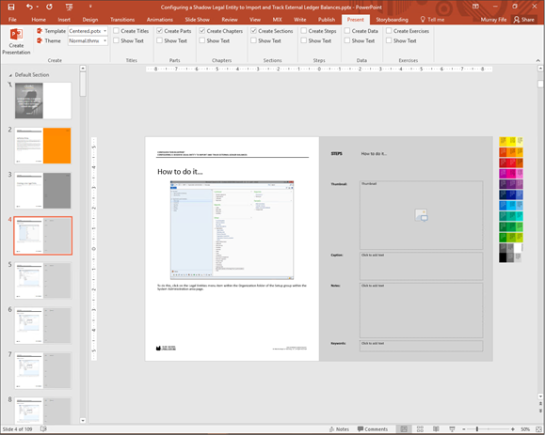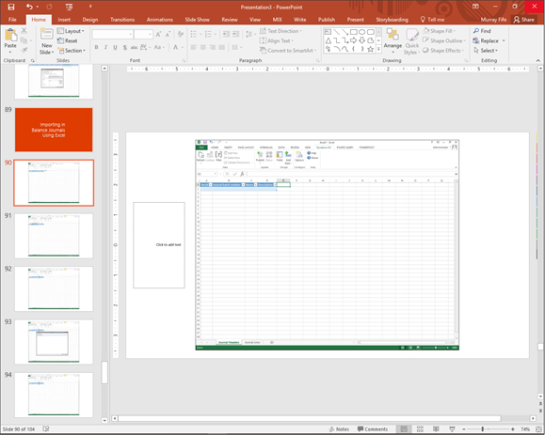Creating Companion PowerPoint Presentations with Author Tools for PowerPoint
Posted by Author, Curator, Visually Impared Squirrel Literacy Advocate & Dynamics AX Technical Solution Professional (TSP) at Microsoft on

Writing walkthrough guides is easy. It’s the formatting of the content that will take you forever to do, especially of you are wanting to repurpose the content into other formats like scripts, blog posts, summaries and even books. And if you want to make a change to a guide, or correct mistakes then that can take just as much time because you might break some of the formatting, or pagination, or you may miss one of the formats. And if you wanted to have specific page breaks, formatting requirements or different page sizes for different versions then it just doubles or triples the work.
Some people may have lackeys or interns that they can give this job to, but I wasn’t one of them, and have literally spent weekends formatting books and transferring images one by one into Word so that I can publish document or create detailed blog post series.
One day it became too much and I decided that I had to stop the insanity and find a better way. Because I capture all of my walkthroughs in PowerPoint – just because it makes everything look consistent and tidy – I looked into how I could automate the process and have it do all of the work for me. I blew the dust off my copy of Visual Studio and created Author Tools for PowerPoint.
These tools automate a lot of the leg work that I used to do manually by using PowerPoint as a repository for all of the walkthrough details and then uses pre-defined word templates as a basis which it then transfers all of the images and text automatically and also formats all of the walkthroughs in a number of different ways based on how you are wanting the information to be consumed. For example, if you are building a book then you may want headings on pages, but if you are publishing it as a blog then you probably don’t.
This reduces the time to format a 400+ page book from 8+ hours and tens of thousands of repetitive keystrokes to probably about half an hour and a single click.
In this walkthrough (which is created with Author Tools for PowerPoint) I will show some of the setup and also how it works.
Creating Companion PowerPoints from Storyboards
If you are using the walkthrough guides for training or for product overviews, then you may be wanting to create companion PowerPoint presentations to help keep everything on track. Although the Storyboard that we create within the Author Tools is a PowerPoint itself, it’s really not designed to be presented to anyone other than you since it’s a framework rather than a polished presentation.
Luckily we thought of that and there is a third component called Present within the Author Tools for PowerPoint that will publish out your storyboard in a more presentable manner, but rather than creating a Word document, it creates a PowerPoint for you based off any PowerPoint template that you have configured with the Author Tools building blocks.
Once you have a storyboard, all you need to do to create the companion PowerPoint is push a button.
How it works…
To do this, all you need to do is open up the Storyboard that you want to convert over into a PowerPoint presentation and the switch to the Present ribbon bar. There you will see a number of different options for publishing your Storyboard to PowerPoint.

If you click on the Template button, you will see all of the different templates that are stored within the AuthorTools/Templates folder for you to create your presentation based on.
To create the PowerPoint, just click on the Create Presentation button within the Create button group.

This will then go out and create the presentation for you.
Also note that although the text is not showing on the presentation itself, the narratives from the Storyboard is actually within the Notes section.

Including Steps in The PowerPoint Presentation
By default, the presentation that is created will be a summary presentation that just includes the Parts, Chapters and Sections for you to use more as an agenda. You can pick and choose from these options, and also you can include detail like the steps within the PowerPoint as well to create more of a self-guided PowerPoint Slideument.
How it works…
If you look on the Present ribbon bar you will see that each of the building blocks for the storyboard are listed there with the option to include them in the presentation.

To include the Steps in the presentation, just click on the Create Steps checkbox to enable it.
Then click on the Create Presentation button within the Create button group.

Now when the presentation gets created, you will see that all of the steps with the pictures have been included in the presentation.

Including Text Within the Slides
Although you don’t normally want to have all of the text from the storyboard within the presentation that you are creating – mainly because it turns the presentation into more of a document, sometimes it is nice to include it as a caption. Don’t fret, you can do this automatically.
How it works…
On any of the building blocks you may have noticed that there is an option to show the text within the slide itself.

To include the text from the steps into the slides, just check the Show Text flag within the Steps button group, and then click on the Create Presentation button.

Now when the presentation gets created, each of the steps within the PowerPoint will have the narrative beside it.


Creating a companion PowerPoint for your document is a great thing to do especially if you have a branded template. You can use the PowerPoint for training, as an overview to your walkthrough, and even as an additional output format to be published on sites like SlideShare. Not having to have to create them by hand is definitely a bonus.
More information…
If this has piqued your curiosity then you can test it out yourself, we have made the install kit available for download for free as the Student Edition.
Just download the kit, install it and then follow along with the examples that are in the book, and also use the samples that are included with the software to see the same examples on your system. You should be able to get it up and running pretty easily and maybe you will find that writing and publishing is not that hard at all.
If you want to grab it, then just follow this link: http://bit.ly/1ZEF5Uo
Also, if you are looking for more resources on then make sure you check out the Blind Squirrel Publishing site at www.blindsquirrelpublishing.com for more articles and books.
About the Author
Murray Fife is an Author of over 25 books which you can find all of his books on Amazon (www.amazon.com/author/murrayfife) and also even more on the BSP (www.blindsquirrelpublishing.com) site.
Throughout his 25+ years of experience in the software industry he has worked in many different roles during his career, including as a developer, an implementation consultant, a trainer and a demo guy within the partner channel which gives him a great understanding of the requirements for both customers and partner’s perspective.
For more information on Murray, here is his contact information:
Email: mcf@blindsquirrelpublishing.com
Twitter: @murrayfife
Facebook: facebook.com/murraycfife
Google: google.com/+murrayfife
LinkedIn: linkedin.com/in/murrayfife
Blog: atinkerersnotebook.com
Docs: docs.com/mufife
Amazon: amazon.com/author/murrayfife
Share this post
- 0 comment
- Tags: Uncategorized
0 comment
